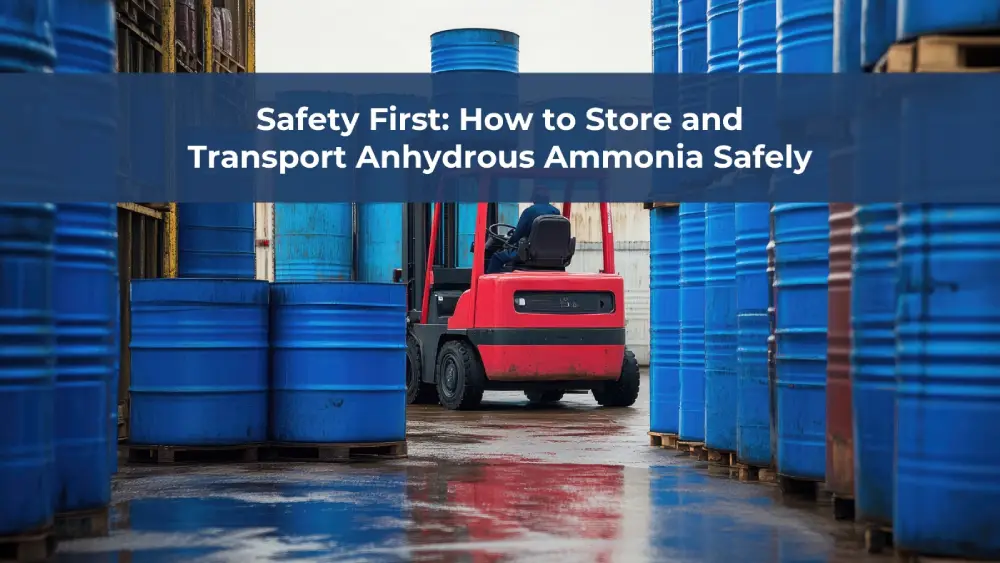Anhydrous ammonia is a highly useful industrial chemical, widely applied in agriculture, refrigeration, and chemical manufacturing. However, due to its toxic, corrosive, and volatile nature, safe handling, storage, and transportation of anhydrous ammonia is absolutely critical. Even minor leaks can pose serious health and environmental risks.
In this blog, we’ll outline best practices for storing and transporting anhydrous ammonia safely, covering regulatory guidelines, equipment, and risk mitigation techniques.
What is Anhydrous Ammonia?
Anhydrous ammonia (NH₃) is ammonia without water, stored as a pressurized liquid. At room temperature and pressure, it exists as a gas. It is:
- Colorless
- Pungent in smell
- Extremely reactive with moisture (including skin, eyes, and lungs)
- A key source of nitrogen in fertilizers
Because of these characteristics, ammonia must be stored and handled with extreme caution.
Risks Associated with Anhydrous Ammonia
Before we get into storage and transport, it’s important to understand why safety protocols are necessary:
- Health Hazards: Causes severe chemical burns to skin and eyes; inhalation can lead to respiratory failure.
- Fire Risk: Not flammable by itself, but it can form explosive mixtures in air under specific conditions.
- Environmental Impact: Leaks can contaminate water and harm plant and animal life.
Safe Storage Practices for Anhydrous Ammonia
1. Use Certified Storage Tanks
- Only store anhydrous ammonia in pressure-rated containers approved by regulatory bodies such as the PESO (Petroleum and Explosives Safety Organisation) in India.
- Tanks should be made from corrosion-resistant materials like carbon steel and Stainless steel.
- Fittings must include pressure relief valves, liquid level gauges, and safety shut-off systems.
2. Ensure Proper Location
- Place tanks in open, ventilated areas, away from ignition sources and high-traffic zones.
- Maintain safe distances from residential or occupied buildings.
- Avoid storing tanks under direct sunlight to prevent pressure buildup.
- The storage tanks are to be kept in a boundary within where there should be no other structures or equipments.
3. Regular Inspections and Maintenance
- Conduct periodic leak checks, valve inspections, and corrosion monitoring (Rule 18 and Rule 19).
- Replace worn gaskets, hoses, or fittings immediately.
- Ensure all safety devices like relief valves are tested and certified annually.
4. Temperature and Pressure Management
- Anhydrous ammonia must be stored below its boiling point (-33°C) under pressure.
- Never overfill tanks — allow space for expansion.
- Use thermometers and pressure gauges to monitor internal conditions.
Safe Transportation Practices for Anhydrous Ammonia
1. Use DOT-Approved Transport Containers
- In India, transport vehicles must comply with CPCB and PESO safety regulations.
- Use tankers specifically designed for anhydrous ammonia, with reinforced piping and certified pressure ratings.
2. Trained Personnel Only
- Drivers and handlers must be trained in hazardous chemical transport, including spill control and emergency response.
- Personal protective equipment (PPE) such as gloves, face shields, and chemical suits is mandatory during loading/unloading.
3. Emergency Readiness
- Vehicles should carry emergency kits, MSDS documents, and proper placards indicating the presence of hazardous material.
- Spill containment protocols and first-aid instructions must be clearly documented.
4. Route Planning
- Choose safe and approved transport routes that avoid densely populated areas where possible.
- Maintain constant communication with dispatch teams to handle delays, breakdowns, or leaks efficiently.
Regulatory Compliance in India
India has several safety frameworks for hazardous chemicals. For anhydrous ammonia, ensure compliance with:
- PESO guidelines
- The Manufacture, Storage and Import of Hazardous Chemical Rules (1989)
- Central Pollution Control Board (CPCB) standards
- Motor Vehicle Rules for hazardous cargo
Manufacturers, suppliers, and transporters must keep documentation updated and available during audits or inspections.
Conclusion
When it comes to handling anhydrous ammonia, safety is not optional—it’s essential. From using the right storage tanks to trained transport handlers, every step must prioritize the prevention of leaks, exposure, or contamination.
Many industries rely on trusted chemical manufacturers who follow rigorous safety standards. Jaysons Chemical Industries, for example, ensures that every stage—production, packaging, storage, and transport—adheres to the highest safety and regulatory protocols, making them a reliable partner for ammonia-based solutions in India.














